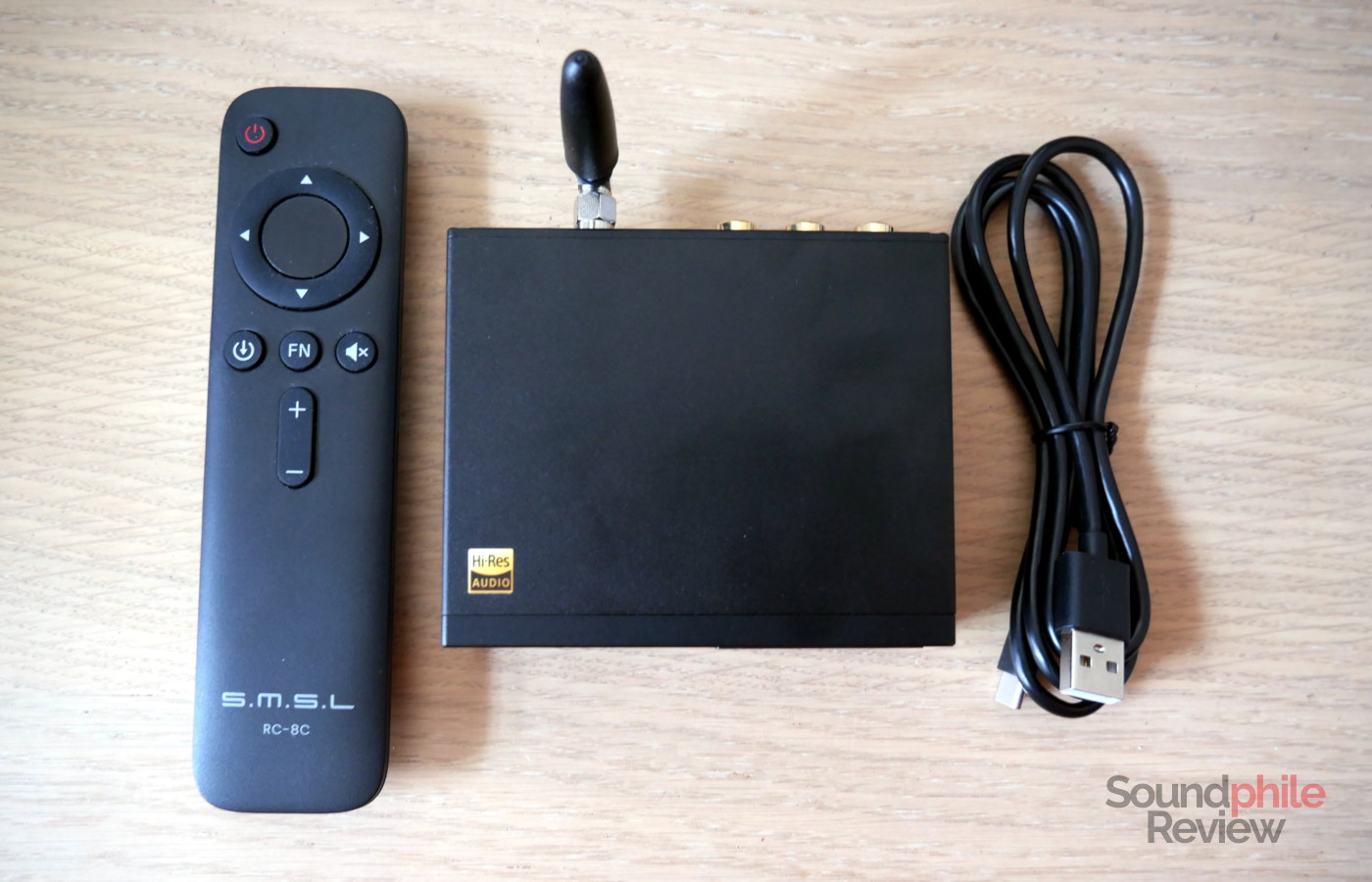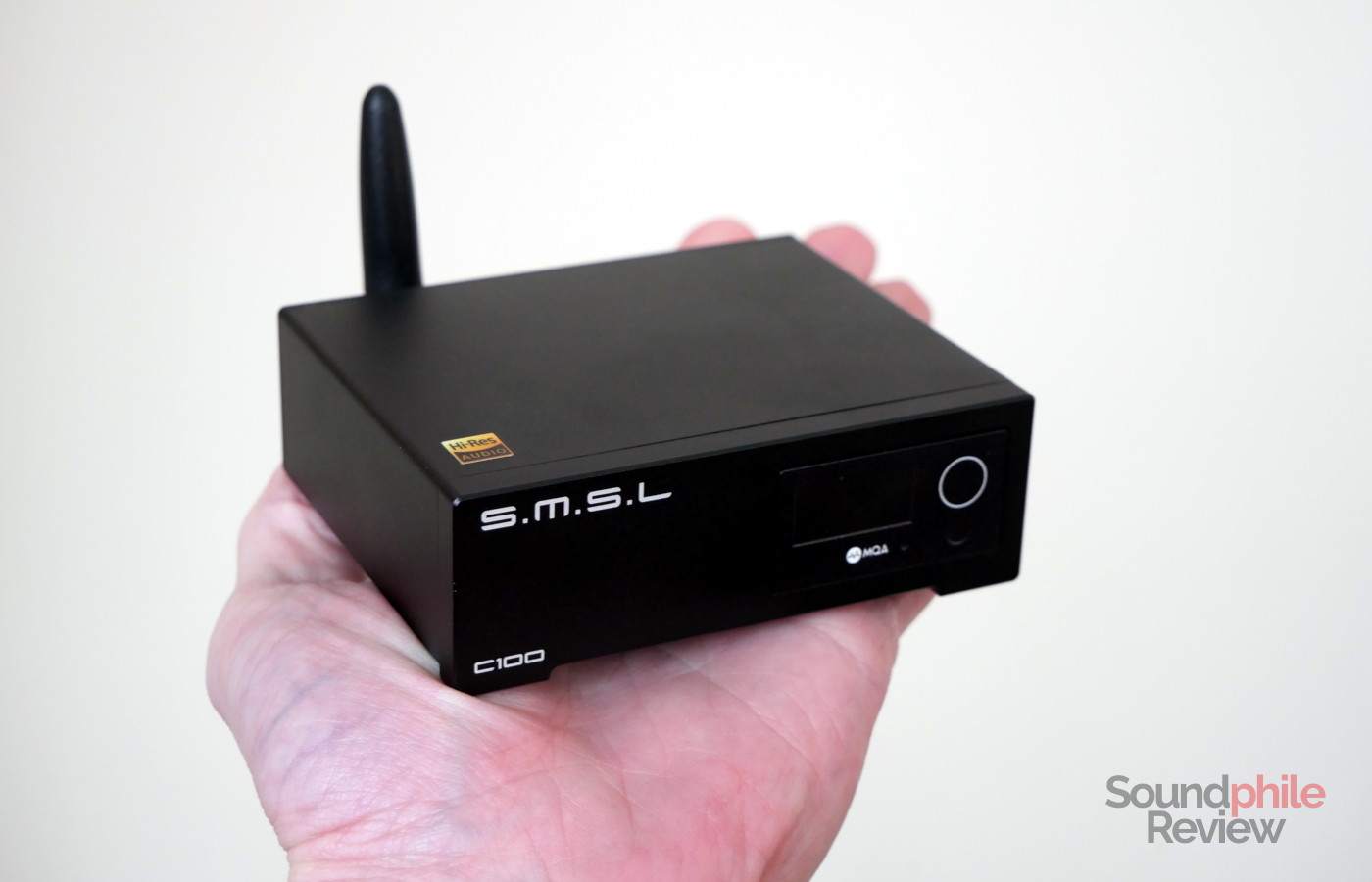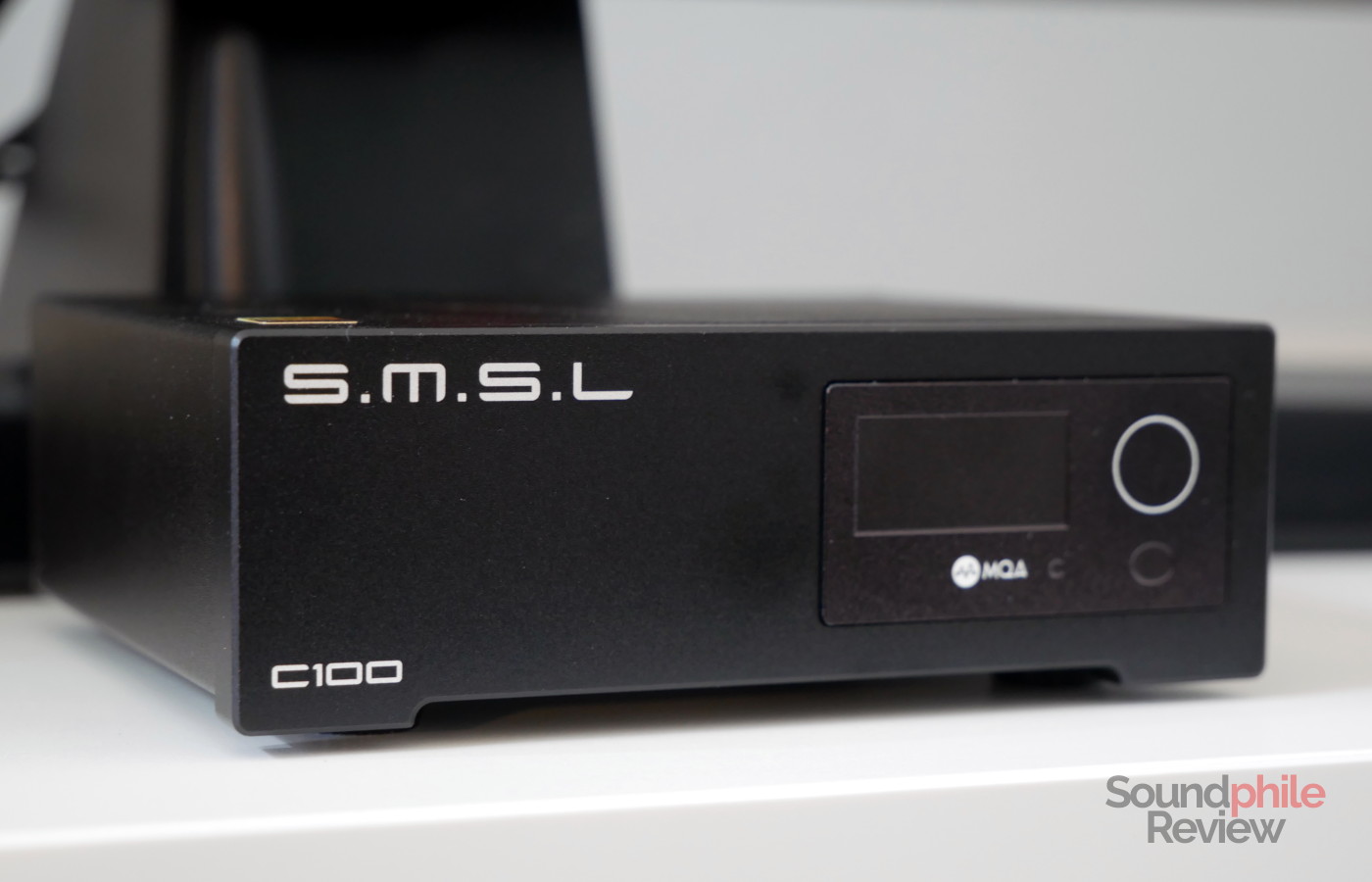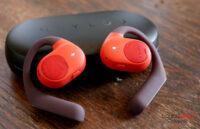SMSL’s thought when designing the C100 seems to have been “let’s see how small we can make it!”. And small indeed did they make it, as the SMSL C100 is one of the smallest DACs you can find around. This makes it especially suitable for a living room setup where you don’t want a large device, but that’s of course not the only scenario.
Disclaimer: I received this unit for free from Aoshida Audio. The C100 retails for $119.
TL;DR: recap
| Pros |
Cons |
| + Good selection of input and output options which includes Bluetooth
+ Super small size + Neutral sound signature + No background hisses, hums, etc |
– No status LED when LCD is turned off |
Rating: 10/10
Packaging & Accessories

The SMSL C100 comes in a simple cardboard box which includes a USB to USB-C cable, as well as a remote and a manual.
Design & Build

The SMSL C100 is really tiny, at just 77.5 x 95 x 32 mm. It’s probably the smallest desktop DAC I’ve tried so far, and it looks so cute! The chassis is entirely made of aluminium, save for the front where there is a plastic insert around the screen.
The front hosts the numeric LCD screen, as well as a touch button. On the back we find the inputs and outputs: inputs include USB (which also acts as the power source), coaxial and optical, while the only output is a pair of RCA connectors. Considering the very limited space available, SMSL really crammed a lot of connectors in there!

Build quality is, as expected from SMSL, great. The C100 looks and feels really well assembled.
Thanks to the small size and the modern design, I feel like the SMSL C100 can blend in easily in any desktop setup as well as in any living room setups. In my case, I have used it with my existing system connected to my TV and it blended in easily. The only possible issue with the small size and light weight is that the cables might be too stiff or too heavy and move the unit, but this is easily solved luckily.
Specs & Features

Despite the small size, the SMSL C100 includes a lot of different connections. It offers USB (through the USB-C port), optical, coaxial and Bluetooth. Output only includes RCA, but it is expected given the size of the device.
Although it doesn’t feature a volume knob, the SMSL C100 can act in both fixed and variable output modes, which is great if you are going to use it with powered speakers or with an amplifier without a remote.
Bluetooth comes in version 5.0 and it only supports the SBC codec, so there’s no support for higher-quality codecs such as aptX or LDAC. Again, being this an entry-level unit it is expected.
The SMSL C100 should work out of the box with all major operating systems, including Linux (and, by extension, the Steam Deck).
SMSL C100 |
| Input range | USB: 16 – 32 bit / 44.1 – 768 kHz, up to DSD512, MQA Optical, coaxial: 16 – 24 bit / 44.1 – 192 kHz; DSD64 via DoP Bluetooth: SBC |
| Output impedance | N/A |
| Frequency response | N/A |
| THD+N (@1 kHz) | < 0.00013% |
| SNR | > 121 dB |
| Crosstalk | N/A |
The SMSL C100 is built around the AKM AK4493S DAC chip, which is a refresh of the AK4493 with the new Velvet Sound topology, which should help reduce noise. The use of this chip is quite interesting, as it sits atop AKM’s line-up and yet it is used in an entry-level device. There’s no word on the amplification chip(s) used.
The remote is the same as the one included with the DO200 MKII and the D300. The up and down buttons double as volume controls, while the FN button turns the LCD screen on and off. Pressing the central button you can access the menu and change the filters as well as adjust the screen brightness.
Sound
I have tested the SMSL C100 in various configurations, including with my desktop computer through USB and my TV (an LG 50 NANO796NE) through an optical connection while feeding a Fosi Audio TB10D powering two Q Acoustics Concept 20.
The SMSL C100 sounds exactly as you would expect, which means it is indistinguishable from other delta-sigma DACs. I’ve tried switching to and from the C100 and a DO200 MKII, without hearing any differences. The C100 shows how far we have come in terms of sound quality in the budget segment. The use of the AK4493S, and its good implementation, surely play a large role in this.
One thing I noticed right away was that the audio from the TV was a bit garbled: high frequencies in particular appeared smeared and lacking in detail. Comparing this to the output from the USB-connected computer, the difference was stark and immediately audible. I’ve then tested the optical input with my computer and it appears to work well, so I would blame this issue on a compatibility issue with the TV: LG TVs are notoriously picky when it comes to optical output and I have tried to use several DACs with my TV without much success, with the SMSL C100 being one of the few that actually outputs anything. More than an issue with the C100, then, this is a warning about possible compatibility issues with other devices.
Final Thoughts
The SMSL C100 is quite a marvellous piece of equipment. It offers great sound with quite a bit of flexibility in the connections it accepts, which makes it ideal for both desktop setups as well as your living room – be it for a stereo home cinema or for a living room listening setup. The fact that it also accepts Bluetooth input makes it also usable with mobile devices, which only amplifies its possible use cases (as well as its usefulness). Overall I feel like the SMSL C100 is the small DAC which most people can (and probably should) look into as it ticks all the relevant boxes and then some more. Absolutely recommended!







Hello,
have you tested the c100 with its original power supply or with better one?
And, one more question, is the c200 worth it compared to the c100?
Hello,
There is no original power supply. The C200 offers an altogether different set of features (e.g. headphone amplifier, balanced output) that makes it a distinct device; the C100 is just a DAC, the C200 is a balanced DAC and headphone amplifier, so it depends on what you need.
I mean, in comparison as a pure desktop DAC. I need DAC for building streaming system to connect to my stereo
Then it depends whether you want/need balanced output or not. If you don’t, then I would say that there’s not much of a difference and the C100 allows you to save a few quid.
There certainly are differences between this very DAC and other Delta-Sigma DACs, or among them generally speaking. You just need a better gear and some training on it first to be able to distinguish it.
how does it compare to the su-1
Hello Roger,
I’m afraid I haven’t tested the SU-1.